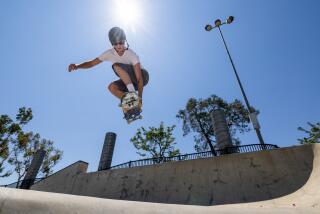Skateboarders, Cyclists, Skaters, Use Your Heads--Wear Helmets
- Share via
As a friend and I set out recently for a morning walk through the Hollywood Hills, we were startled by three kids who rounded the street corner and blew by us on their skateboards.
We watched with admiration and amusement as they moved and grooved down the long, winding hillside. I was particularly impressed by their effortless athletic abilities. Each youth clearly had his or her own style, but all were equally graceful while navigating the hills.
Then suddenly it occurred to me that they were clocking about 30 mph on L.A.’s busy streets--and they were not sporting helmets.
Don’t get me wrong, I’m all for freedom of expression, but skateboarding, inline skating, biking or even tooling around on a scooter without wearing a helmet is almost as dumb as jumping from a plane without a perfectly packed parachute.
“Even if your lifestyle takes you along winding country roads, it’s a good idea to protect yourself,” says Dr. Andrew Feldman, director of Sports Medicine at St. Vincent’s Hospital in New York City. “When you’re young, you’re more reckless, and you don’t know your boundaries yet. You think you’re immortal.”
Pamela Griffith, a nurse and the trauma program manager at Childrens Hospital in Los Angeles, has seen firsthand the results of that recklessness.
“The most common injuries we see at Childrens Hospital for skaters are wrist fractures,” Griffith says. “When people fall, they tend to put their hands out behind their back to break the fall, which can cause hyperextension of the wrists and abrasions and lacerations.”
But the doctors and nurses also see many cases of head traumas, most of which are preventable with smart riding and the use of quality protective equipment.
Consider this:
* The U.S. Consumer Product Safety Commission estimates that 3 million head injuries associated with sports in general were treated in hospital emergency rooms in 1998. About 440,000 of these were concussions and skull fractures due to cycling, skating and skateboarding.
* The National Safety Council and National Center for Injury Prevention say that only one out of 10 bicyclists wears a helmet, and three-fourths of inline skaters with head injuries were not wearing helmets.
* A 1989 study published in the Journal of the American Medical Assn. reported that 85% of fatal wheeled-sports-related head injuries could have been prevented with helmets.
“Wrist guards and kneepads are necessary,” Feldman says. “Helmets are absolutely mandatory.”
Choosing, Using Helmets
Fifteen states, including California, and parts of Canada have mandatory bike helmet laws for kids. Inline skaters and skateboarders usually skate at their own risk.
The Consumer Product Safety Commission sets standards for cycling and skating helmets, so look for a sticker saying the helmet meets the commission’s standard. The standard inline skating helmet is identical to the standard bicycle helmet.
Although there is no standard helmet for skateboarders, they are advised to use one designed for cycling.
But helmets have to be worn correctly in order for them to work. Many helmet users don’t secure their helmets level on their heads; others don’t adjust the straps properly.
“Make sure to get your kids to hook the chin strap,” says Troy Rodriguez, skateboarding expert from EarthSports.com. “Often they run out the door with their helmets on, but the straps aren’t buckled, so if they fall, the helmets aren’t of much use.”
Additionally, parents should make sure that kids’ helmets aren’t tilted back on their heads, leaving their foreheads vulnerable.
To ensure a proper fit:
* The helmet should be worn low on the forehead (two fingertips above the eyebrows).
* The helmet should sit flat on the head, evenly between the ears.
* The chin strap should be tightened and the inner pads adjusted so that the helmet fits snugly.
* The helmet shouldn’t move from side to side.
These guidelines will ensure that the helmet can absorb the energy of an impact. Additionally, the helmet should be made of crushable, expanded plastic foam that has a hard outer shell to protect against collision with a sharp object.
Most reputable sporting goods stores carry standard safety helmets for all ages, except for children younger than 1 (nobody recommends taking an infant on a bicycle).
Parents should look for helmets with vents (which kids appreciate) and, for toddler helmets, sets of fit pads (to adjust for growth).
As my friend and I continued our morning hike through the Hollywood Hills, I couldn’t help but think about those skateboard riders. I’m going to climb on a skateboard someday soon, but you better believe--hills or no hills--I’ll be sporting a helmet.
Other Tips
But safety doesn’t stop there. As I found out on my walk, where you skate matters.
Rodriguez suggests a smooth, flat surface for skateboarding and inline skating. Extreme skaters, those who perform jumps, spins, flips and grinding (riding down steps and poles), are exposed to greater risk.
Wood ramps are suggested for athletic feats because they have more give and can help absorb the impact of a fall. Concrete swimming pools, popular with young riders, should be avoided, however, because the landing surface is too unforgiving.
For more safety tips or guidelines, contact:
* Consumer Products Safety Commission: (800) 638-2772 or https://www.cpsc.gov.
* American Red Cross, which offers a sports safety training course called “Safe Wheels.” The class teaches kindergartners through sixth-graders about basic bicycle safety, including how to prevent bicycle injuries and the importance of helmets. Call (818) 243-3121 or (800) 627-7000.
*
Stephanie Oakes is a fitness correspondent for Discovery Health Channel. She can be reached at stephoakes@aol.com. Her column runs the fourth Monday of every month.
More to Read
Sign up for Essential California
The most important California stories and recommendations in your inbox every morning.
You may occasionally receive promotional content from the Los Angeles Times.













